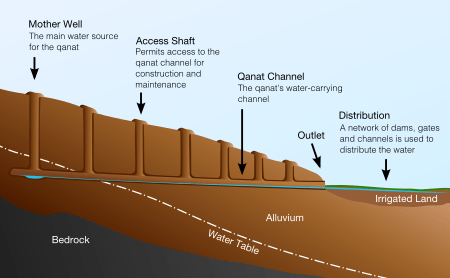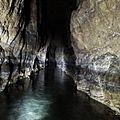Qanat facts for kids
A qanat is a very old and clever system of tunnels and wells. It's built to bring water from deep underground to places where people live or grow crops. This water usually comes from natural underground water sources, like water that has soaked into the ground from mountains. Qanats have been used for thousands of years, especially in dry, desert areas of the Middle East. The oldest qanats were found in a region called Persia (which is now Iran). Some of these ancient water systems are believed to be more than 2,000 years old!
What is a Qanat?
A qanat is like an underground river that people built. It's not just one well, but a whole series of wells connected by gently sloping tunnels. These tunnels are dug to slowly carry water from an underground water source to the surface. This way, water can travel many miles without evaporating in the hot sun.
How Qanats Work
Building a qanat starts by finding an underground water source, often at the base of a mountain. Workers dig a main tunnel from this source. This tunnel slopes very gently downwards, allowing gravity to pull the water along.
- Mother Well: This is the first and deepest well, dug down to the water table (the level where the ground is full of water).
- Underground Tunnel: From the mother well, a long, slightly sloped tunnel is dug. This tunnel carries the water.
- Access Shafts: Along the tunnel, vertical shafts (like smaller wells) are dug from the surface down to the tunnel. These shafts help with digging and maintenance. They also let air into the tunnel.
- Output Channel: Eventually, the main tunnel reaches the surface. Here, the water flows out into an open channel or pool. From there, it can be used for drinking, farming, or other needs.
This system is very smart because it uses gravity, so no pumps or machines are needed to move the water. It also protects the water from evaporating, which is very important in hot, dry climates.
Where are Qanats Found?
Qanats were first developed in ancient Persia, which is modern-day Iran. From there, the idea spread to many other parts of the world. You can find qanats (or similar systems) in:
- The Middle East: Countries like Iran, Afghanistan, and parts of North Africa.
- Asia: Places like China (where they are called karez) and India.
- Europe: Parts of Spain, where they are known as viajes de agua.
Many of these ancient qanats are still working today, providing water to communities just as they did thousands of years ago. They are amazing examples of ancient engineering and how people adapted to live in challenging environments.
Images for kids
-
A qanat tunnel near Isfahan
-
Yakhchāl of Kheshti in Yazd Province
-
A kariz surfacing in Niavaran, Tehran. It is used for watering the grounds of The National Library of Iran.
-
Ancient Persian water clock
-
Water "metering" through a distribution weir on a foggara in Algeria
See also
 In Spanish: Qanat para niños
In Spanish: Qanat para niños














